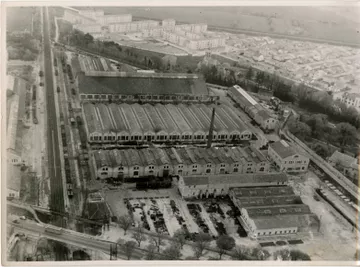

The landscaped park
Designed by landscape architect Bas Smets, the 10-acre landscaped park features 500 new trees and a large pond.
Explore the landscape park with Bas Smets
Dive into the history and design of the LUMA Arles landscaped park through three audio walks guided by landscape architect Bas Smets.
These self-guided tours, available directly on your smartphone, offer a new way to explore the park—tracing the key stages of its transformation.
Historical context
In the 19th century, the industrial site of the Parc des Ateliers was built. Its entire surface was covered with a concrete slab.
From the end of the 1st century BC, a Roman necropolis was built in Arles along the Aurelian Way. Although it initially only hosted cremations in its oldest part, near the ramparts, over the following centuries the necropolis was extended to the south-east, to the present site of the church of Saint-Honorat, where, as tradition has it, the Arles martyr Genès was buried in the 3rd century AD. Numerous stone sarcophagi, both simple and elaborate, bear witness to the history of this pagan and then Christian cemetery, which remained in use until the 15th century.
In the middle of the 19th century, the PLM company began construction of the Parc des Ateliers in Arles on the site of part of the Alyscamps necropolis. Work began in 1844 with the levelling of the plot to be built using dynamite (many stone sarcophagi were excavated, buried, or destroyed on that occasion). The entire surface of the site was then covered with a concrete slab to facilitate the establishment of the buildings and the passage of locomotives.
Landscaped park project
LUMA Arles called on landscape architect Bas Smets to turn the Parc des Ateliers into a public landscaped park.
Key facts and figures
- Surface area of the parc: 41,800 square meters
- Surface area of the pond: 2,500 square meters
- More than 500 newly planted trees
- Period of work: 2017 – 2021
A brand-new topography for the Parc des Ateliers
The former industrial site of the Parc des Ateliers consisted of a large concrete platform without any vegetation, resulting in arid climatic conditions. Bas Smets’ project was to transform it into a lush park. In order not to damage the many archaeological remains still present in the subsoil, a fertile soil was placed on the barren concrete, which gave the horizontality of the site a brand-new topography, as though it had been sculpted by the winter mistral winds blowing from the northwest. Over time, these strong winds shape a dune-like landscape. Such asymmetry provide shade in the summer months, while offering protection from the strong winds of the winter months.
A hybrid and compressed landscape, as a stroll in the region
Bas Smets drew inspiration from the unique landscapes surrounding Arles – the Camargue, the Crau, and the Alpilles – and used their specific logics and strategies to bring back vegetation to the site. Trees, shrubs, grasses, and ground covers were introduced to the topography, creating a new landscape on the site. More than five hundred new trees of different sizes and species were planted in the Parc des Ateliers. All species are native to the Mediterranean region, including strawberry trees (Arbutus unedo), evergreen oaks (Quercus ilex), Montpellier maples (Acer monspessulanum) and stone pines (Pinus pinea).
The pond, a climate tool for the park
The vegetation growth is made possible by a sustainable water circulation system that draws its source from the Craponne canal, built between the Durance and the Rhône in the 16th century to promote agriculture, and located near the park. The large pond serves both as a water reservoir for irrigation and as a cooling device on hot summer days. The pond, as well as the new topography and its vegetation, produce a microclimate, effectively transforming the concrete desert into a lush public park.
Bas Smets
His projects vary in scale from territorial visions to infrastructural landscapes, from large parks to private gardens, from city centres to film sets.
Each of these projects is part of an encompassing research into the possible roles of landscape projects. The aim is to invent ‘Augmented Landscapes’ by using the logics of nature. These augmented landscapes produce a new climate while creating new atmospheres.
Awards and Honors
In 2021, the landscaped park was nominated in the "Public Spaces and Landscapes" category of the Equerre d'Argent, an architecture award.
In 2024, the landscaped park received the 2024 Grand Jury Prize at Les Victoires du Paysage, an event organized by Valhor, the interprofessional organization dedicated to promoting horticulture, floristry, and landscaping professions and products.









